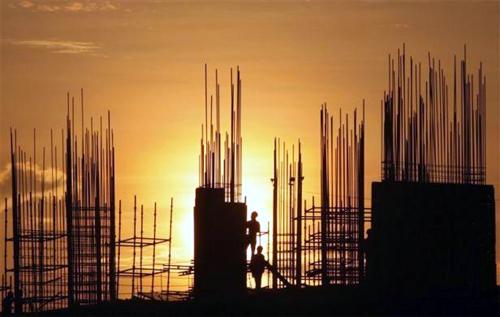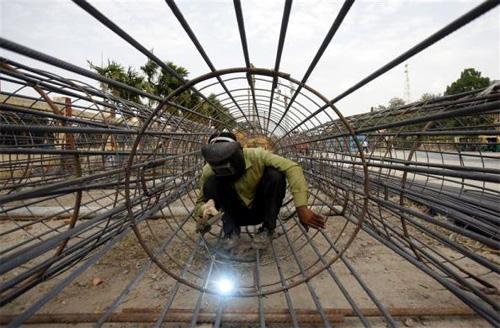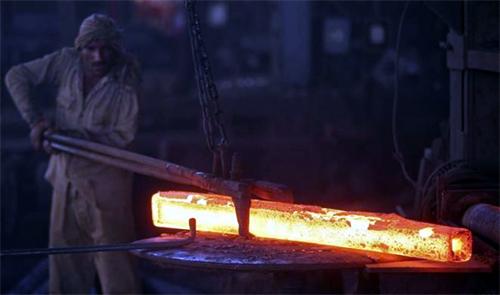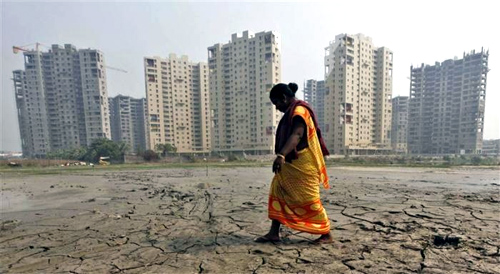Photographs: Krishnendu Halder/Reuters N Chandra Mohan
The United Progressive Alliance government appears to be upbeat regarding the prospects of its flagship scheme, the Mahatma Gandhi National Rural Employment Guarantee Act, which provides a universal, self-targeting guarantee of 100 days of employment to every household in all rural districts of India.
"MGNREGA has tremendous potential to increase agricultural production, which we have not been able to tap fully to date. . . .There is no doubt that MGNREGA can play a big role in fulfiling our dreams of a second green revolution," said Congress President Sonia Gandhi at an MGNREGA conference.
To be sure, there are a number of problems that plague the implementation of MGNREGA, including corruption, administrative paralysis and other hardy perennials. Massive amounts of funds on this scheme remained unspent in 2010-11 and 2011-12.
. . .
Complete coverage: Union Budget 2013-14
Budget Impact Live!
MGNREGA's second innings: How India can alleviate poverty
Image: Labourers work at the construction site of a flyover on the outskirts of Ahmedabad.Photographs: Amit Dave/Reuters
But, since it kicked off in 2006, it has become one of the largest employment programmes in the world, generating 13.48 billion person-days of work.
A person-day is one person working for a day.
One in four rural households was provided jobs when alternative employment was not readily available during the lean months of the agricultural season.
There is no doubt that this countrywide social safety net has enhanced livelihood security for a large number of beneficiaries.
The average wage earned per beneficiary has risen from Rs 65 per person-day in 2006 to Rs 115 per person-day in 2012.
Research has suggested that such a scheme has exerted upward pressure on agricultural wage rates, boosting real wages by 5.3 per cent.
. . .
Complete coverage: Union Budget 2013-14
Budget Impact Live!
MGNREGA's second innings: How India can alleviate poverty
Image: A worker welds iron rods at the Metro railway construction site in Kolkata.Photographs: Parth Sanyal/Reuters
The massive injection of funds, a bulk of which was spent on wages, under this scheme has also been held responsible in large part for the faster pace of rural than urban spending between 2009-10 and 2010-11.
However, the bad news is that MGNREGA is losing momentum.
Employment generation has hit a downtrend, with the biggest declines being registered for the marginalised sections like scheduled castes and scheduled tribes and women, according to a recent article by Subodh Varma in The Times of India.
From a peak level of 54 person-days of employment per rural household in 2009-10, this flagship scheme generated 47 person-days in 2010-11, 43 person-days in 2011-12 and 35 person-days in 2012-13 (till early February).
According to the Economic Survey 2011-12, the slight fall in 2010-11 'may be due to the fact demand came down owing to a good monsoon'.
. . .
Complete coverage: Union Budget 2013-14
Budget Impact Live!
MGNREGA's second innings: How India can alleviate poverty
Image: Labourers work on iron rods at the construction site of a flyover at Noida in Uttar Pradesh.Photographs: Parivartan Sharma/Reuters
Officials also attributed the huge unspent amount in the scheme in 2010-11 and 2011-12 to a lower demand for MGNREGA jobs.
The economy was doing well and there were better opportunities elsewhere.
But this logic doesn't hold thereafter.
In 2012-13, growth is likely to hit a low of five per cent.
The monsoon, too, was not so bountiful but employment fell even when distress ought to have spiked upwards the demand for it.
Why would there be less demand for MGNREGA work, especially when wages have spiralled upwards?
In Maharashtra, the notified wages have registered an increase of 200 per cent.
The lowest increase was a 30 per cent rise in Kerala.
. . .
Complete coverage: Union Budget 2013-14
Budget Impact Live!
MGNREGA's second innings: How India can alleviate poverty
Photographs: Parivartan Sharma/Reuters
More importantly, in as many as 19 states, the MGNREGA wage is now higher than the legal minimum agricultural wage.
Such a differential ought to encourage greater participation in the scheme -- particularly when the monsoon was not so good this financial year -- but the employment generation numbers indicate otherwise.
However, the average number of days per household is only one criterion to judge an extremely ambitious scheme like MGNREGA.
Professor Raghav Gaiha, formerly with the Faculty of Management Studies, University of Delhi, has assessed the performance of the scheme with other criteria like the percentage of households completing 100 days of work, the percentage of expenditure against total available funds and the percentage of work completed -- see his article with Raghbendra Jha, "NREGS: Interpreting the Official Statistics", in the Economic and Political Weekly, on October 6, 2012.
. . .
Complete coverage: Union Budget 2013-14
Budget Impact Live!
MGNREGA's second innings: How India can alleviate poverty
Image: A worker fastens iron rods together at the construction site of a bridge on Srinagar-Jammu national highway in the outskirts of Jammu.Photographs: Mukesh Gupta/Reuters
Gaiha and Jha find MGNREGA's performance to be disappointing across all the four criteria, barring the percentage of households completing 100 days of work.
The actual expenditures on the scheme hit a high of Rs 39, 377 crore (Rs 393.77 billion) in 2010-11 and declined thereafter to Rs 38,035 crore (Rs 380.35 billion) in 2011-12, and Rs 25,075 crore (Rs 250.75 billion) in 2012-13 (till December).
As a share of available funds, this represents a decline from 73 per cent to 63 per cent.
As if all these weren't bad enough, the percentage of work completed also fell sharply from 51 per cent in 2010-11 to 14.5 per cent in 2012-13 (till December).
MGNREGA's loss of momentum stems from all these factors.
. . .
Complete coverage: Union Budget 2013-14
Budget Impact Live!
MGNREGA's second innings: How India can alleviate poverty
Image: A woman labourer walks past a residential estate under construction in Kolkata.Photographs: Rupak De Chowdhuri/Reuters
Far from reflecting lower demand, the scheme appears to be impacted by a stressed fiscal situation because expenditures are steadily decreasing.
The low share of work completed points towards a larger failure to design and implement appropriate projects at the grass-roots level.
Despite all these problems, MGNREGA must be made to work, since it offers a historic opportunity for the transformation of rural India, including a second green revolution.
If implemented with watershed development and other infrastructure schemes, it can eradicate rural poverty.
Mahatma Gandhi National Rural Employment Guarantee Act, 2005 "Report to the People", Ministry of Rural Development, Government of India, February 2, 2013
MGNREGA Sameeksha, an anthology of research studies on the Mahatma Gandhi National Rural Employment Guarantee Act, 2005, 2006-12 Ministry for Rural Development, Govt of India, published by Orient Blackswan, 2012









article